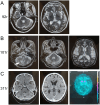Non-coding repeat analyses in patients with Parkinson's disease
- PMID: 40765612
- PMCID: PMC12321559
- DOI: 10.3389/fneur.2025.1606305
Non-coding repeat analyses in patients with Parkinson's disease
Abstract
Introduction: The genetic etiology of Parkinson's disease (PD) is complex; approximately 10% of patients with PD have various gene mutations that lead to familial forms of the disease. Recent analyses of non-coding repeat regions revealed that many neurodegenerative diseases are associated with pathological expansions. We evaluated the genetic background of non-coding repeat expansions in Japanese patients with PD.
Methods: We collected blood samples from 203 Japanese patients with PD and analyzed various non-coding repeat genes, including ATXN8OS, RFC1, C9ORF72, NOTCH2NLC, BEAN1/TK2, and NOP56, using PCR-Sanger sequencing, repeat-primed PCR assay, and long-read sequencing.
Results: Three patients with PD (1.5%) were found to have heterozygous repeat expansions in ATXN8OS, the gene causative of spinocerebellar ataxia type 8 and is associated with long non-coding RNA. One (0.5%) patient had compound heterozygous repeat expansions (AAGGG and ACAGG) in RFC1, the gene causative of cerebellar ataxia, neuropathy, and vestibular areflexia syndrome, which encodes a DNA repair protein. No patient had repeat expansions in C9ORF72, NOTCH2NLC, BEAN1/TK2, or NOP56. All patients with ATXN8OS repeat expansions exhibited typical parkinsonism with relatively rare subjective dysphagia, which was confirmed by videofluoroscopic results. Functional imaging, such as dopamine-transporter single photon emission computed tomography, showed abnormal findings in patients with non-coding repeat expansions.
Discussion: Our findings revealed the importance of non-coding repeat expansions in Japanese patients with PD. This is the first study to show the positive result of non-coding repeat expansions in many patients with PD in Japan.
Keywords: Canvas; RFC1; dysphagia; parkinsonism; repeat disease; spinocerebellar ataxia type 8; videofluoroscopic analysis.
Copyright © 2025 Hirano, Samukawa, Miyatake, Yamagishi, Isono, Yoshikawa, Saigoh, Terayama, Higashimoto, Koshimizu, Mizuguchi, Fujii, Mitsui, Matsumoto and Nagai.
Conflict of interest statement
The authors declare that the research was conducted in the absence of any commercial or financial relationships that could be construed as a potential conflict of interest. The author(s) declared that they were an editorial board member of Frontiers, at the time of submission. This had no impact on the peer review process and the final decision.
Figures





References
LinkOut - more resources
Full Text Sources

